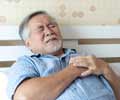Everyone should learn to recognize cardiac arrest, perform CPR, use an AED, to rescue more cardiac arrest patients.

"Early emergency care by the bystander, long before emergency medical providers arrive, can save a life. This care is referred to as ’pre-arrival care,’" said Brady. "This pre-arrival care is as important as more advanced care by EMTs, nurses, and doctors once trained providers are available."
‘Calling 911, using AED, proper CPR training, increasing the number of people getting trained could help more cardiac arrest victims survive.’
Read More..




Calling 911, Beginning CPR Read More..
The first step is simply noting that someone may be in cardiac arrest.
The article notes that the American Heart Association and other medical groups "recommend that bystanders should suspect cardiac arrest and begin CPR whenever a person is unresponsive and not breathing normally." Faster recognition of cardiac arrest will also lead to a quicker 911 call, speeding the arrival of trained emergency medical providers.
But research has shown that bystanders can help cardiac arrest victims by beginning CPR themselves (major groups like the American Heart Association now endorse compression-only CPR, which is performed using chest compressions only and not breathing into the victim’s mouth).
A 2010 review of more than 10,000 out-of-hospital cardiac arrest cases found that 22.1% of patients receiving pre-arrival care, including bystander CPR, survived, compared with 7.8% of patients that did not.
Advertisement
Bystanders can further help a cardiac arrest victim’s chances of survival by also using an AED. Brady helped spearhead an effort to install more than 300 AEDs across Grounds, helping UVA earn a HEARTSafe Campus award from the National Collegiate EMS Foundation twice in recent years.
Advertisement
This highlights the benefits of quick action from bystanders. As Brady’s article notes, "for every minute that a person with out-of-hospital cardiac arrest goes without CPR and defibrillation, the chance of survival decreases by 7 to 10%."
The Need for Education
One major barrier to bystanders providing lifesaving care for cardiac arrest victims is a lack of training, especially in how to perform CPR. Brady’s article points to a study that estimates only 2.4% of Americans receive CPR training each year.
One potential way to boost the number of people getting trained, Brady and his co-authors write, is to offer shorter training sessions. Potential options include 4-minute training sessions at CPR kiosks in public locations, as well as video training sessions ranging from 60 seconds to 8 minutes.
Another option to boost bystander care is one Brady hopes will soon be available in Central Virginia: a smartphone app that notifies volunteer users of a cardiac arrest occurring near them in a public location.
This would enable people close to the scene to start CPR and use an AED, if available, before emergency medical providers arrive. Albemarle County Fire Rescue, Charlottesville Fire Department, the Charlottesville-Albemarle-UVA Emergency Communications Center and UVA Health are working together to launch this tool.
"The next major advance in cardiac arrest management is not a new hospital-based treatment nor fire-rescue intervention. It is this pre-arrival care performed by a bystander, before fire-rescue personnel arrive and long before a patient is transported to the hospital. This care can allow victims of cardiac arrest to return to their lives and families," Brady said.
Source-Eurekalert












